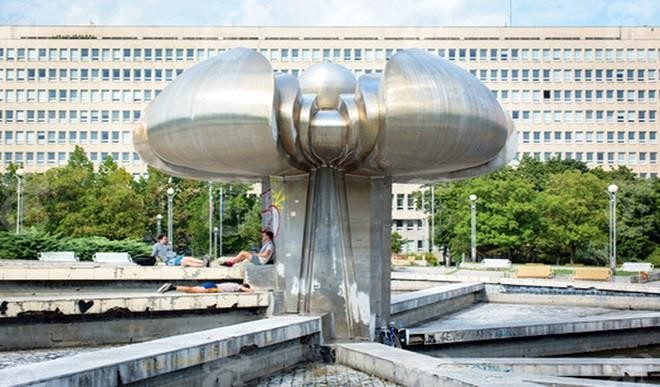
Some destinations lure visitors with evocative phrases suitable for travel brochures: The fountains of Rome. The rooftops of Paris. The souks of Marrakesh.
The panelaks of Bratislava, Slovakia’s capital on the Danube, will never make the list. The term, though, is potent. And the sight is a marvel – assuming, under the category of the marvelous, that you count, as I do, the existence of the largest concentration of graceless concrete high-rise housing units ever to stomp across the landscape of a Central Europe country formerly under Communist control.
The word itself is a colloquial expression in Czech and Slovak, with roots in both languages’ more technical compound term for “panel house”: Prestressed and prefabricated, panelaks were rapidly assembled and cheaply built to solve a post-World War II housing crisis. They also expressed a basic aspect of Soviet ideology, providing egalitarian habitat for humanity – even if it was a humanity that couldn’t afford to complain about bad insulation, leaky windows, structural weaknesses and mechanical failures.
Hungarians and Poles have their own related words for similar complexes; the high-rises of Central Europe were, after all, once the Eastern Bloc rage. And the impulse to provide one-size-fits-all urban shelter can be seen everywhere around the globe from London council flats to Cabrini Green in Chicago, built between 1942 and 1962 and torn down between 1995 and 2011, and the infamous Pruitt-Igoe complex, first occupied in St. Louis in 1954 (designed by Minoru Yamasaki, architect of the World Trade Center), and demolished by dynamite and despair in 1972.
But in Europe, panelak prevails as the name for the buildings and all they signify because more of them were built in the former Czechoslovakia – in a boom that stretched from 1959 to 1995 – than any place else on what was once Soviet earth. Today, about a third of all Czechs and Slovaks, from all income brackets, still call their panelaks home. Some 130,000 residents live in the Bratislava complex alone, concentrated in the city’s Petrzalka district.
Václav Havel, first post-Communist president of the Czech Republic, famously called his country’s signature housing “undignified rabbit hutches, slated for demolition.” Yet the panelaks of Bratislava endure with no less determination than Bratislava Castle, their ancient Old Town neighbor across the Danube. And the Petrzalka populace, resolutely adapting to whatever failures of promise the 21st century continues to dump on them, goes about its business. Before the rabbit hutches, in 1945, the area served as an internment camp for nearly all of the city’s Hungarian population. Before that, from 1938 to 1945, it was annexed by Nazi Germany. For a time in 1944, it was a labor camp for Hungarian Jews.
Small wonder that today’s residents are utterly uninterested in any visitor who strolls among the monoliths, contemplating the low points of miscalculated 20th-century urban engineering and political ideology made manifest in concrete. But that’s where contemplation led me on a suitably gray afternoon late last November. I had surveyed the city’s more picturesque sampling of Baroque Christian architecture and Jewish ruins on a previous visit, and I was based in a cheery, simple pension in Vienna for a few days of meandering when I felt the call of the high-density district sometimes caricatured as the Bronx of Bratislava.
A spur-of-the-moment day trip is an easy railway commute from one European capital to the other. Teaming up with a game fellow solo traveler I had met the same morning in the pension’s little breakfast room, we departed from the gleaming, spotless, newly built Wien Hauptbahnhof, Vienna’s central station. About an hour later, we arrived in the exhausted, illogical welter of the central station called Bratislava Hlavna Stanica.
There are, to be sure, some striking relics of the city’s era of Communist Big Weird Buildings to ogle – architectural eruptions that regularly draw visitors with fancier cameras than mine. The essential tour includes the massive inverted pyramid called Slovensky Rozhlas, built to house Slovak Radio; the menacing 1970s extension of the Slovak National Gallery; and Namestie Slobody, or Freedom Square. But for maximum atmospheric challenge, my walking partner and I limited our itinerary to the panelaks of Petrzalka, the bridge that got us there and whatever ground we covered to walk between the two. We piled onto a tram that appeared to be going in the right direction, and jumped off as we approached the bridge.
We could have easily spent an hour just gawping, and a solid 10 minutes learning the various names for the span: Most SNP, i.e., the Bridge of the Slovak National Uprising (as the bureaucrats call it); Novy Most, i.e., New Bridge (as the people call it); or the UFO Bridge, as new visitors are bound to call it, a natural nickname given the flying saucer-shaped folly at the top of the pylon that anchors the Petrzalka end of the asymmetrical structure. These days, for a fee, an elevator takes tourists to an observation deck under the jurisdiction of a fancy restaurant called UFO.
Exhibiting a mad declaration of totalitarian will over common sense, with a bonus jab of contempt thrown in, the masterminds who made this bridge wrecked a good chunk of the city’s historically important Old Town, managing to tear up nearly all of the Jewish quarter, to impose a major roadway. In a fit of what goes around comes around, the bridge’s three designers were on the outs with the regime by the time the structure officially opened in August 1972, and their names were left off the dedication plaque.
We left the embankment of everything old and walked along the lower level of the New Bridge, safe for pedestrians and bicyclists, while cars passed by on the upper level. The panelaks of Bratislava are just beyond, a mile or two over; we could see them, spread like a rash. And when we set foot on the embankment of everything new, we headed in the direction of the housing mirage ahead of us.
But first, we walked through an homage to new capitalism – past the sprawling Aupark shopping center, and through the shiny high-rise corporate complex called Digital Park. Global enterprises including Bayer, Shell and Lenovo call the campus their Bratislava home. Sleek cafes beckon at ground level. A big neon sign advertises Digital Golf. Young businessmen in jackets stood around outside, smoking. Bratislavan women checked their smartphones. We walked on. We cut into side streets. We passed receptacles for dog droppings. We reached the panelak perimeter. We strolled around courtyards.
One problem: There are no real courtyards. There are no natural areas for people to gather, or even pause; no shops; no services. The urban-studies matriarch Jane Jacobs, who warned the world about the alienation of high-rise sterility, would have said, “See what I’m talking about?” The architect and high-rise champion Le Corbusier would have said, “Uh-oh, my bad.” We walked for about an hour, attuned to small, post-Communist upgrades of color on selected outside walls – yellow, red, apricot, a bluish gray. Potted plants appeared in a few glass entryways. We learned that insulation has been upgraded in some buildings, and that some of the notoriously cramped flats have been reconfigured. The publishers of the home-improvement magazine called PanelPlus clearly know their readership.
Later, in my own prewar apartment building just a short walk from Manhattan’s panelak-like Lincoln Towers, I would study photos online to learn that the Ikea sensibility can go a long way toward improving the feng shui of a minuscule panelak kitchen.
There is no hipster irony in panelak living, no retro cool. No economic disadvantage is implied by the address, either, nor, at this point in the game, any political ideology. The place just is, extraordinary and mundane, gargantuan and invisible. On the other hand, my friend and I were keenly aware of the ironies of tourist privilege when we decided, on our way back across the New Bridge, to spring for lunch at the UFO restaurant.
The elevator took us up to a snazzy circular space, decorated in a mix of ‘90s restaurant cool with touches of broadly self-aware black humor; consider, at the bar, the sculpture of a Stasi-like secret policeman, spying with a long-lens camera. The meal was luxe, the tasting menu was something called “mediterasian,” the service was almost unceasingly attentive, and the total bill for two, with fancy lunchtime drinks, was under $120. We lingered over a rich dessert, looking out toward the Old Town, Stare Mesto, where Hungarian kings were crowned in St. Martin’s Cathedral beginning in the 16th century, and where river boats anchor to disgorge tourists for day trips.
Then, before we headed back to the train station and commuted to the dispassionate elegance of Vienna, we made stops in the restaurant loo. The toilet faced toward Petrzalka, with a view of all the panelaks of Bratislava, spread out below, disappearing over the horizon.
Distributed by The New York Times Syndicate

 Join Daily Trust WhatsApp Community For Quick Access To News and Happenings Around You.
Join Daily Trust WhatsApp Community For Quick Access To News and Happenings Around You.


